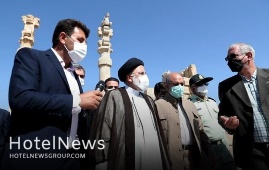
Iranian President Seyyed Ebrahim Raisi on Thursday said the UNESCO-registered Persepolis is an epitome of the great Persian art. Persepolis displays the great artistic achievements of Iranians from past millennia, which are still remarkable and admirable after so many centuries, the president said. He made the remarks during his visit to the prestigious site, which was once the ceremonial capital of the mighty Achaemenid Empire (c. 550 – 330 BC). [The ruins of] Persepolis is also conveying a message to oppressors warning them of the fate of those who are cruel to humanity, he added. The royal city of Persepolis ranks among the archaeological sites which have no equivalent, considering its unique architecture, urban planning, construction technology, and art. Persepolis, also known as Takht-e Jamshid, whose magnificent ruins rest at the foot of Kuh-e Rahmat (Mountain of Mercy) is situated 60 kilometers northeast of the city of Shiraz in Fars province. The city was burnt by Alexander the Great in 330 BC apparently as revenge to the Persians because it seems the Persian King Xerxes had burnt the Greek City of Athens around 150 years earlier. The city’s immense terrace was begun about 518 BC by Darius the Great, the Achaemenid Empire’s king. On this terrace, successive kings erected a series of architecturally stunning palatial buildings, among them the massive Apadana palace and the Throne Hall (“Hundred-Column Hall”). This 13-ha ensemble of majestic approaches, monumental stairways, throne rooms (Apadana), reception rooms, and dependencies is classified among the world’s greatest archaeological sites. Persepolis was the seat of the government of the Achaemenid Empire, though it was designed primarily to be a showplace and spectacular center for the receptions and festivals of the kings and their empire. The site is marked by a large terrace with its east side abutting the Kuh-e Rahmat (“Mount of Mercy”). The other three sides are formed by a retaining wall, varying in height with the slope of the ground from 13 to 41 feet (4 to 12 meters); on the west side, a magnificent double stair in two flights of 111 short stone steps leads to the top. On the terrace are the ruins of several colossal buildings, all constructed of a dark gray stone (often polished to a marble-like surface) from the adjacent mountain. According to Britannica, the stone was cut with the utmost precision into blocks of great size, which were laid without mortar; many of them are still in place. Especially striking are the huge columns, 13 of which still stand in the audience hall of Darius I (the Great; reigned 522–486 BC), known as the Apadana, the name given to a similar hall built by Darius at Susa. There are two more columns still standing in the entrance hall of the Gate of Xerxes, and a third has been assembled there from its broken pieces. In 1933 two sets of gold and silver plates recording in the three forms of cuneiform—ancient Persian, Elamite, and Babylonian—the boundaries of the Persian empire were discovered in the foundations of Darius’s hall of audience. Several inscriptions, cut in stone, of Darius I, Xerxes I, and Artaxerxes III indicate to which monarch the various buildings were attributed.
Create: Oct 16, 2021 Edit: Oct 16, 2021 Regional News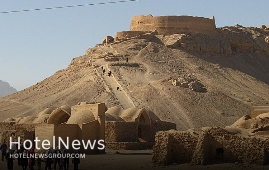
The enigmatic Zoroastrian Towers of Silence are set on two lonely, barren hilltops on the southern outskirts of Yazd in central Iran. According to a tradition dating back over 3,000 years, dead bodies were left on top of those open towers – which are also called dakhmas -- to be slowly disengaged or picked apart by desert vultures. Under ancient Zoroastrian beliefs about the purity of the Earth, dead bodies were not buried but left in these uncovered stone towers so that vultures could pick the bones clean. Narratives say that men’s corpses were placed in the outer circle, while women’s were left in the middle, and children in the inner-most ring. Bodies were then left until their bones were bleached by the elements and stripped by the vultures. After the process of purification, bones were placed in ossuaries near, or inside the towers. Ossuaries from these rituals have been discovered from the 4th and 5th centuries BC. At the foot of the hills are several other abandoned Zoroastrian buildings, including a defunct well, cistern, kitchen, and a lavatory. As Iran developed and urbanized, dakhmas became increasingly closer to city limits, severely curtailing their use. Since the 1970s, the use of dakhmas has been illegal in Iran, forcing orthodox Zoroastrians to adapt to new burial methods. According to Encyclopedia Britannica, such towers are about 25 feet (8 m) high, built of brick or stone, and contain gratings on which the corpses are exposed. After vultures have picked the bones clean, they fall into a pit below, thereby fulfilling the injunction that a corpse must not suffer contact with either fire or earth. Zoroastrian Towers of Silence are currently one of the famed travel destinations of Yazd, which is a cradle of Zoroastrianism. In July 2017, the historical texture of the city of Yazd was named a UNESCO World Heritage. Wedged between the northern Dasht-e Kavir and the southern Dasht-e Lut on a flat plain, the oasis city enjoys a very harmonious public-religious architecture that dates from different eras. With its winding lanes, a forest of badgirs (wind catchers), mud-brick houses, atmospheric alleyways, and centuries of history, Yazd is a delightful place to stay, referring to as a ‘don't miss’ destination by almost all travel associates in the region. Yazd Jameh Mosque, Dowlatabad Garden, the Yazd Atash Behram, also known as Atashkadeh-e Yazd, Towers of Silence, and adjacent desert landscape are among its tourist sites. Here is a selection of comments that visitors to the Zoroastrian Towers of Silence have posted to TripAdvisor, one of the most popular travel websites in the world: ‘Wonderful’ Should be visited to understand the ancient beliefs of Zoroastrians... This is a place where are the Zoroastrians buried their dead in the sky... (Fatih U from Izmir, Turkey) ‘Eerie’ A must site to visit if you are in Yazd to check out how the Zoroastrians dispose of their dead as they believed that after death the soulless body is impure and by burying the impure corpse in the ground, the soil becomes contaminated with impurity. (shadgerami from Nikolayevsk-on-Amur, Russia) ‘An extraordinary site’ We had planned to visit a dakhma when we toured Uzbekistan but had to give it a miss, so I was eager to visit these in Yazd. I had not realized that buildings are having a ritual function associated with the dakhma. Each family has its own building where a final funerary meal is eaten before the deceased is taken to the dakhma for excarnation. It was fascinating to walk around that part of the site before ascending the dakhma. The ascent is quite steep but aided by proper steps. Once in the main platform, there are excellent information boards in English explaining the processes undertaken. (Rod F from Royal Wootton Bassett, UK) ‘Spookily beautiful’ It is one of the most interesting sites we visited on our trip to Iran and one of the greatest reasons to add Yazd to the tour program. Totally recommended! (Muge S from Istanbul, Turkey) ‘A unique place to visit’ I can imagine how hot it must be here in the summer... we visited Yazd at Christmas time and the weather was perfect, sunny but not too hot. Climbing up to the hill makes you sweat but standing right where the corpses were left is a unique experience that catches one’s imagination. There are helpful postings in English that help you understand the context and the customs. You really can’t miss this if you visit Yazd. (Joscar00 from Stockholm, Sweden) ‘Interesting history!’ Easy walk/hike to the top. One of the towers is on a much higher level than the other. Best time to go early morning or before the sunset. (Aida B from Los Angeles) ‘Very interesting place with strong energy flow’ Don’t miss the whole story of this place as it makes it so unique and special. Going up is essential to see the whole place. Also, it gives good views around. There is very strong energy there. Going up to one of the towers is rather enough but you can choose the less popular one. This place is worth 20 min drive from the city center. (Very-sunny from Lodz, Poland) ‘A very interesting and beautiful place’ For millennia and until recently, in the 1970s, this place was used to dispose of the dead, a high priest would chop the pieces of the bodies to be fed to the birds. It is located outside the city and you can visit it on tour or by taxi. There are some temples or buildings at ground level and then you have the two hills with their sanctuaries on top. A great experience. (Etienne T. form New York) ‘Must do in Yazd’ A unique place to visit. Read a bit about the background before you come as all explanation is only in Farsi. Walk up the tower and try to imagine how the burial ceremony must have been like in those days. A must-do when in Yazd. (Isabella Deruiter form Rotterdam, the Netherlands) ‘Iconic place in Yazd with very interesting history’ This place is an essential part of the Zoroastrian religion, where the followers lay their dead loved ones' bodies at the top of the tower for the scavenging birds and weather to 'disintegrate' the bodies. The ascent to the top requires a basic level of fitness but the view of Yazd city from the top is good. I remember seeing motorbikes that bring you to the top too. (Wei T. from Singapore)
Create: Oct 13, 2021 Edit: Oct 13, 2021 Regional News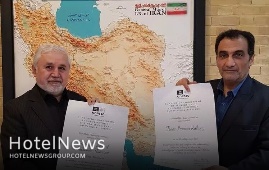
Certificates of registration of four Iranian UNESCO World Heritage sites have been handed over to the tourism ministry, the deputy tourism minister has announced. The Ministry of Cultural Heritage, Tourism, and Handicrafts has received registration certificates of four cultural heritage, which have been listed by UNESCO over the last two years, IRNA quoted Ali Darabi as saying on Friday. The ministry has received certificates for Trans-Iranian Railway, Cultural Landscape of Uramanat as tangible cultural heritages as well as the art of miniature, jointly with Azerbaijan, Turkey, and Uzbekistan and pilgrimage to St. Thaddeus jointly with Armenia, as UNESCO Intangible Cultural Heritage, the official added. Having a global register of tangible and intangible heritage is vital because these works, regardless of race, nationality, and religion, belong to all human society, and all governments and nations have a duty to preserve and protect them, even during times of war, he noted. Increased recognition of a country’s cultural heritage on the World Heritage list certainly contributes to the development of the tourism industry and businesses related to it, and most importantly, introduces the culture and civilization of a nation to the world, he explained. With 26 World Heritage Sites, Iran ranks 10th in the world in terms of the number of historical monuments and sites registered on the UNESCO World Heritage list. Before the Islamic Revolution, Persepolis, Naghsh-e Jahan Square, and Choghaznabil were the only three UNESCO-listed monuments, but today the number has been increased this number to 26 historical sites. Trans-Iranian Railway The railway can be regarded as a turning point for comprehensive developments in Iran. These developments include a wide spectrum of various economical, commercial, social, cultural, and even political aspects in a sensitive and important period of contemporary world history. Consequently, the 1394 kilometers long Trans-Iranian Railway was built with a width of 1435mm and 90 working stations along its route. It starts at a point north of Torkaman port located southeast of the Caspian Sea. After going through Sari and Qaem-Shahr cities, the railway enters the mountainous region of Alborz through the high Firooz-kooh Pass which is linked with Tehran and Varamin Plain by numerous bridges and tunnels. Further on after crossing the flatlands of Qom and Arak, the Trans-Iranian Railway penetrates Zagros highlands in Lorestan Province and passing through a large number of tunnels and bridges reaches Andimeshk situated in the low Kuzestan Plain. Finally extending to the vicinity of Dezful, Ahwaz, and its grand bridge on Karoon, the Trans-Iranian Railway is divided into two branches ending separately at Khoram-Shahr and Imam-Khomeini ports on the Persian Gulf. Cultural Landscape of Uramanat Stretched on the slopes of Sarvabad county, and shared between the provinces of Kordestan and Kermanshah, the rural area of Uramanat embraces dense and step-like rows of houses in a way that the roof of each house forms the yard of the upper one, a feature that adds to its charm and attractiveness. As the cultural landscape covers 300 villages and in terms of architecture and landscape, it is one of the most beautiful and presentable heritages in the world. Uraman is considered a cradle of Kurdish art and culture from the days of yore. Pirshalyar, which is named after a legendary local figure, is amongst time-honored celebrations and rituals that are practiced annually across the region. The art of miniature The miniature is a type of two-dimensional artwork that involves the design and creation of small paintings on books, paper-mâché, rugs, textiles, walls, ceramics, and other items using raw materials such as gold, silver, and various organic substances. Historically, the miniature was exemplified by book painting in which the text was supported visually, but the element has evolved and can also be observed in architecture and as an adornment in public spaces. The miniature displays a specific type of perspective in which the size of the figures changes according to their importance - a key difference between realistic and naturalistic styles. Though it has existed for centuries, it continues to develop and thus strengthens the bonds between past and present. Traditional painting principles and techniques are preserved, but artists also bring individual creativity into the process. Pilgrimage to the St. Thaddeus The annual three-day pilgrimage to St. Thaddeus Apostle Monastery in northwestern Iran is held each July. The pilgrimage venerates two prominent saints: St. Thaddeus, one of the first apostles preaching Christianity, and St. Santukhd, the first female Christian martyr. The bearers of the element are the Armenian population in Iran, Iranian-Armenians residing in Armenia, and followers of the Armenian Apostolic Church. Pilgrims gather in Tabriz before departing for the monastery. They cover 700 kilometers from Yerevan to the monastery annually. The commemoration ceremony includes special liturgies, processions, prayers, and fasting. It culminates in a Holy Mass with Holy Communion. Special times are set aside for traditional Armenian folk performances and Armenian dishes are served. The pilgrimage is the primary social and cultural event of the year.
Create: Oct 10, 2021 Edit: Oct 10, 2021 Regional News
Iran is prepared to repair and restore Syrian historical monuments and tourism infrastructure that have been destroyed by the Islamic State in Iraq and Syria (ISIS), the deputy tourism minister Ali-Asghar Shalbafian has announced. He made the remarks during a meeting with the Syrian Minister of Economy and Foreign Trade Mohammad Samer al-Khalil on Sunday in the Expo 2020 Dubai. “The Iranian restorers can then exchange experiences with Syrian specialists,” the official added. He also emphasized Iran’s readiness to strengthen communication and develop tourism ties between the two countries. Health tourism and medical tourism is one of Iran's most important strengths in the tourism sector, and we welcome Syrian tourists to make use of this opportunity,” he noted. Al-Khalil for his part said that there is an increasing interest among Syrian tourists in visiting Iran, especially its northern coasts, as well as to Iranian holy cities, so the necessary grounds need to be created. The Expo 2020 Dubai opened on Thursday with a lavish ceremony of fireworks, music, and messaging about the power of global collaboration for a more sustainable future. Iran’s pavilion in the world fair is planned to showcase each Iranian province’s strengths and assets in tourism, cultural heritage, handicrafts, as well as its natural sites, traditional ceremonial practices, and historical significance. Many countries and companies are also looking to the expo - the first major global event open to visitors since the coronavirus pandemic - to boost trade and investment. According to organizers, the Expo, an exhibition of culture, technology, and architecture under the banner “Connecting Minds and Creating the Future”, is expected to be a demonstration of ingenuity, and a place where global challenges such as climate change, conflict, and economic growth can be addressed together. The Persian Gulf state has relaxed most coronavirus limitations but Expo requires face masks to be worn and for visitors over 18 to be vaccinated against, or test negative for, COVID-19. Iran expects to reap a bonanza from its numerous tourist spots such as bazaars, museums, mosques, bridges, bathhouses, madrasas, mausoleums, churches, towers, and mansions, of which 26 being inscribed on the UNESCO World Heritage list.
Create: Oct 3, 2021 Edit: Oct 9, 2021 Regional News
Residence Inn by Marriott, part of Marriott Bonvoy’s portfolio of 30 extraordinary brands, announced today the opening of its newest property, Residence Inn by Marriott Bogotá. Marking Residence Inn’s debut in Colombia, the hotel is located at Calle 90 # 16-30, just a few steps from 93rd Street Park and in the middle of the most vibrant and cosmopolitan area in the Colombian capital. Operated by oxoHotel — a company specialized in the conceptualization, development and operation of multi-brand and multi-segment accommodations — the new Residence Inn by Marriott Bogotá welcomes business and leisure travelers with upscale design and architecture that enhances the guest experience with open spaces to relax and live without constraints. Residence Inn by Marriott Bogotá provides direct access to Chicó Market (Mercado del Chicó), an innovative gastronomic complex with more than 30 gastronomic offerings, located adjacent to the hotel, as well as to Bodytech Calle 90, one of the best medical sports clubs in Colombia. “We are very pleased to introduce the Residence Inn by Marriott brand for the first time in Colombia,” said Diane Mayer, Vice President & Global Brand Manager of Classic Select Brands, Marriott International. “We’ve seen increased demand for longer stay brands that offer modern amenities, open room layouts and sophisticated design to spread out, recharge and maintain a healthy balance while on the road, whether for business or for fun. Travelers can make the most of their stay by choosing the Residence Inn by Marriott Bogotá.” The hotel offers 131 all-suite, flexible guest rooms including studios and one- or two-bedroom suites. Guests will feel right at home with separate areas for living and sleeping with plush bedding and linens, providing an intimate atmosphere that invites connection and productivity. The hotel design makes use of organic materials and textures combined with warm colors, transition palettes, as well as textiles and ancestral Colombian goldwork that feature crisp and inspiring details, offering comfort the moment a guest enters the hotel lobby. LONGER STAY Designed for stays of five nights or more with maximum benefits in mind, Residence Inn stands out for its modern residential decor based on the idea of ‘travel the way you live.’ It is a concept where openness, freedom and love for life translate into personalized service and unrestricted experiences. Fully equipped kitchens in each suite – complete with a refrigerator, cook top, microwave, dishwasher, residential-size appliances, and dishes and cookware – set the stage for home-cooked meals, paired with Residence Inn’s complimentary grocery delivery. Guests will also appreciate large in-suite workspaces with a well-lit desk, ergonomic seat and high-speed wireless internet access. Residence Inn offers a wide variety of healthy and natural options on rotation for its daily complimentary breakfast, included in the room rate. We are delighted to open the first Residence Inn in Colombia in an area surrounded by impressive shops, restaurants and experiences that invite business and tourism. Each suite has been developed to create sensations of being close to home with personalized welcoming moments,” said Juan Carlos Galindo, CEO of oxoHotel. “With this opening, we are not only reaffirming our intention to offer enhanced experiences to our guests, but also to reignite tourism and new hotel projects in Colombia.”
Create: Aug 1, 2021 Edit: Aug 1, 2021 International News
PARSIPPANY, N.J. – July 15, 2021 – Wyndham Hotels & Resorts, the world’s largest hotel franchising company with over 8,900 hotels across nearly 95 countries, today announced the opening of La Quinta Inn & Suites by Wyndham Nashville Downtown/Stadium, featuring the brand’s Del Sol prototype. There are 175 La Quinta hotels in the development pipeline, with openings scheduled this year in key U.S. markets such as Austin, Texas; Brooklyn, N.Y.; Denver, Colo.; and Santa Cruz, Calif. Internationally, the brand, which currently operates in Canada, Chile, Colombia, Honduras, Mexico, Turkey, and New Zealand, has also announced plans to further expand in China, the Dominican Republic, Mexico, and the United Arab Emirates. La Quinta’s Del Sol prototype was created with the objective to maximize revenue-per-sq.-ft. while maintaining a competitive cost per key. It features a fresh, stylish and innovative design, providing guests with comfort and convenience while enabling productivity, making it appealing to both business and leisure travelers. La Quinta has continued to garner the interest of developers due to its strong performance of gaining 490 basis points of RevPAR Index in 2020 against its competitive set, according to STR data. Dedicated to guest service and satisfaction, La Quinta by Wyndham offers an elevated stay in a contemporary setting. With thoughtful amenities and friendly service, this brand consistently delivers an exceptional guest experience that keeps travelers waking up on the bright side. Located along the East Bank of Nashville’s Cumberland River, La Quinta Inn & Suites by Wyndham Nashville Downtown/Stadium debuts 205 spacious guest rooms outfitted with amenities to relax and recharge, more than 2,000 square feet of event space, an on-site restaurant and bar, a business center to stay connected, a fitness center to squeeze in a workout while on the road, and a welcoming heated indoor pool. The hotel also offers amenities ranging from laundry facilities and dry cleaning service to Bright Side Breakfast®. With modern, locally inspired design elements, including an expansive hand-tiled mosaic reflective of the city’s music scene behind the front desk, the heartbeat of Nashville is evident throughout the hotel. “We are delighted to bring La Quinta Inn & Suites by Wyndham’s Del Sol prototype to the bustling city of Nashville,” said Krishna Paliwal, Wyndham’s president of La Quinta and head of architecture, design, and construction. “Timed with the return of the summer travel season, we are excited to expand the brand’s portfolio and welcome visitors to this very special southern city.” La Quinta Inn & Suites by Wyndham Nashville Downtown/Stadium is located nine miles from Nashville International Airport, across the street from Nissan Stadium, home to the Tennessee Titans, and minutes from the excitement of Broadway. Visitors can immerse themselves in music history with a visit to the Grand Ole Opry and Ryman Auditorium, see Elvis’ Cadillac and additional iconic memorabilia at the Country Music Hall of Fame and Museum, or catch a Predators game at Bridgestone Arena. Centennial Park is nearby and home to a full-scale replica of the Parthenon, as is the stunning 55-acre botanical garden at Cheekwood. Business travelers can expect to be conveniently located near companies like Amazon, Bridgestone, and iHeartRadio.
Create: Jul 17, 2021 Edit: Jul 17, 2021 International News
South Florida’s iconic Boca Raton Resort & Club announces the most significant evolution in its history, and its new-again name —The Boca Raton. For over four decades, from 1944 to 1988, The Boca Raton name signified a luxurious lifestyle unmatched worldwide. Over the coming months, The Boca Raton will usher in an entirely new perspective on travel, A New Golden Era. A New Golden Era at The Boca Raton and The Boca Raton Club promises an unrivaled destination beginning with a $175 million Phase One physical transformation to be unveiled during Winter 2021/2022. There will be bespoke enhancements to every guest experience, from exceptional accommodations to dynamic culinary concepts and innovative programming. The Boca Raton has a remarkable history as an internationally recognized landmark and a private escape for in-the-know travelers,” said Daniel A. Hostettler, President & CEO of The Boca Raton. “A New Golden Era will pay homage to the resort’s storied past while introducing innovative new amenities and experiences that will inspire both members and guests, and define The Boca Raton as one of the world’s most preeminent luxury resorts and private clubs.” Five Distinct Hotel Experiences, One Iconic Resort. The Boca Raton will feature a collection of five hotels located Beachside and Harborside, each with its own personality and style. Beach Club: The oceanfront luxury escape features three pools set on a private stretch of golden beach. The hotel’s new Mediterranean dining concepts, Marisol and the lobby lounge, are curated by notable lifestyle guru Colin Cowie. Bungalows: Ideal for extended stays, this three-story residential hideaway features two-bedroom suites with full kitchens and furnished terraces and balconies. Tucked in a serene corner of the property surrounded by a lush landscape, the Bungalows offer a private pool and dedicated amenities. Yacht Club: The adult-only, all-suite luxury hotel embodies refined lakefront leisure. Elegant suites feature private balconies, and views of Lake Boca Raton and its yacht-lined promenade. Personal concierges and floor valets prepare every detail for the perfect escape. Reopening Winter 2021. Cloister: Stay where it all started amidst grand architecture, lush grounds and hidden gardens as an unforgettable backdrop. Located in the heart of the action, the resort’s original structure is just steps from the 18-hole golf course, Racquet Club and spa. The Cloister is being revitalized and will reopen with immersive experiences and rotating art collections. Reopening Winter 2021. Tower: Providing elevated perspectives for sophisticated travelers, the 27-story tower is undergoing a $45 million complete transformation by Rockwell Group. With extraordinary vistas of sparkling waterways, the all new luxury hotel will introduce flexible suite configurations—two to three bedrooms—artful touches, bespoke amenities and butler service. Opening first quarter 2022. A World of Flavor. From fine dining to waterfront bites, The Boca Raton is creating one of the most exciting culinary destinations in the country, including four signature experiences with Major Food Group (MFG). The Flamingo Grill, opening this month, offers a glamorous take on the mid-century American chophouse. Forthcoming restaurants include Sadelle’s, the inventive, perennially packed brunch institution with locations in New York and Las Vegas, and all new concepts exploring Japanese and Italian cuisine. Only at The Boca Raton. This winter, the resort will unveil Harborside Pool Club, a four-acre lakefront oasis featuring luxury cabanas, four pools, 450-foot lazy river, two three-story high slides, double standing wave, retail boutique, 7,100 square foot event lawn, 5,000 square foot kids club, and a teens lounge, as well as new waterfront dining options. The Boca Raton’s 40,000 square foot wellness oasis has unveiled a new name, Spa Palmera, and new treatments. This winter, Spa Palmera will showcase a refreshed design and additional programming. New one-of-a-kind experiences include a supercar racing adventure, perfect for thrill seekers. Fashionistas may opt for a curated shopping day with a personal stylist, while couples can spend the afternoon on a private boat, complete with snorkeling and live entertainment. Resort owners MSD Partners and Northview Hotel Group are stewarding the property into its new phase with an award-winning team of builders and creators. Visionaries include architecture and design firm Rockwell Group, landscape architecture firm EDSA, branding and marketing agency King & Partners, and GarciaStromberg—a firm of architects, designers and artists.
Create: Jul 17, 2021 Edit: Jul 17, 2021 International News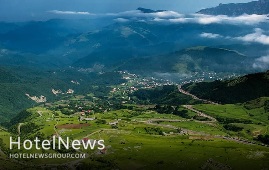
Countries are defined geographically and politically by their borders. Borders are fundamentally linked to tourism, as travel almost always entails crossing a political or another boundary, and borderlands are often the first or last areas of a country visited by travelers. Iran has a total of 5,894 kilometers of land borders with its neighbors Afghanistan, Armenia, Azerbaijan, Iraq, Pakistan, Turkey, and Turkmenistan. It also borders the Caspian Sea, Persian Gulf, and the Gulf of Oman. Several border cities dot Iran, owing to the vast size of the country’s land borders. The border cities of Iran, however, have limited tourist numbers due to their long distances from the country’s center, as well as the fact that they have not been properly promoted for foreign visitors. Here are some of the most beautiful border cities that have always gone unnoticed. Astara Astara, an Iranian border city and port, offers a wide range of tourist attractions. It is a major tourist and economic center on the west coast of the Caspian Sea, in the Gilan province. It is the last point of the border between Iran and Azerbaijan. Hakim Nezami School and Shindan Castle are two of the city’s historical sites. Astara Lagoon, Astarachay river, Qarasu river, Chelvand river, Darband river, Lavandvil river, and Espinas mountain are some of the city’s natural attractions. Among Iran’s border regions, Astara is the only area that has not experienced any tensions in the last 80 years, making it one of the safest. There is a great deal of tourism in this region because of the natural beauty and the weather. Jolfa Located in northwestern East Azarbaijan province, Jolfa borders the countries of Armenia and the Republic of Azerbaijan to the north. Jolfa has a semi-desert climate with warm summers and partly cold, moderate winters. The special importance of Jolfa is due to its historical monuments, strategic location, and appropriate geographical features, as well as its proximity to the commercial and industrial free zone of Aras (one of Iran’s most important commercial centers). Seyyed Abolqasem Nabati tomb, Duzal tower, Saint Stepanos Monastery, Nane Maryam church, ruined mill, Ushtibin village, St. Mary church, Baba Yaqub shrine, Ali Beyg fort, Jolfa historical bath and etc., are the most significant monuments and tourist attractions in this area. The region’s economy is fueled by the abundance of water resources, grasslands, and forest reserves, as well as its high potential for growth and industrialization. Minerals, agriculture, livestock, services, and scientific and training development also play an important role. There are a lot of cotton fields in this city, and weaving is the major activity of the locals. Jolfa people are Azeri and they speak in Turki Azerbaijani in their own local dialect. Maku Maku is located northwestern province of West Azarbaijan and enjoys a unique geographical and natural location. In a valley passes through which the Zangmar River divides Maku into two parts, the city is located 1294 meters above sea level. The city is surrounded by the Qarasu River and Turkey from the north, the Aras River (the Nakhchivan Autonomous Republic and Armenia) from the east, Khoy from the south, and Turkey from the west. Due to the surrounding stony mountains, this city has a moderate climate in winter and a hotter climate in summer. Mountainous landscapes, flourishing pastures, hot water springs, waterfalls, protected areas, and hunting grounds are some of the tourist attractions of this area. Maku is located on the main Tabriz-Bazargan road and has an excellent strategic location. Among the city’s most significant features is its role as the country’s only land border business and a link to Europe. As part of Maku’s economy, there is an industrial complex on the Maku-Bazargan road. Maku people rely on cross-border trade, agriculture, and animal husbandry for their livelihood. Zahedan The city of Zahedan is located in eastern Iran close to the Pakistani border. There are high lands around Zahedan, so it looks like a pit. The city is home to the mountains of Oshtoran Koh, Anjir Dan, Jico, Pir Khan, and Mulk-e Siah. Climates in this area are characterized by intense heat, aridity, and warmth. Zahedan consists of 4 parts: "Markazi", "Mir Jave", "Nosrat Abad", and "Korin", three cities, and eight rural districts. It is an academic, cultural, historical, and religious city that has a service structure. Zahedan enjoys a privileged geographic and border location which makes it an ideal place for trade with India thanks to its convenient location on the Afghanistan-Pakistan route. Pakistan’s railway enters Iran from the Mirjaveh border and Iran’s railway ends in this city. By being located among the Khorasan, Kerman, and Chabahar land routes, Zahedan is one of the Iran transit routes. Zahedan’s economy depends on agriculture in addition to trade. There are subterranean, spring, and river wells that supply the water this city needs. This area is full of color in its literature, clothing, and music. Zahedan’s cultural diversity results from migration. A good example of Baluch handicrafts is the klim bafi, needlework, seke dozi, and pottery. Zahedan architecture is influenced by Iran's ancient architecture due to its tropical weather. Baneh One of the border cities between Iran and Iraq, Baneh is located in the western province of Kordestan. The city is located 20 kilometers from the Iranian-Iraqi border, 60 kilometers southwest of Saqez and 70 kilometers southeast of Sardasht. The city is known for its large and natural oak forests. In 1984, Iraqi planes bombed Baneh and some nearby settlements during the Iran-Iraq war (1980-1988). Dul Arzan village, Shevi cave, Baneh Dam, Sorin complex are among the city’s tourist attractions, however, most of its reputation comes from its border malls and its status as a trade center. Local people speak Kurdish with Slemani accent.
Create: Jul 17, 2021 Edit: Jul 17, 2021 Regional News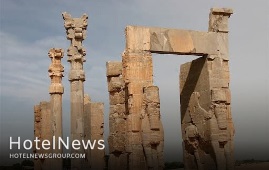
The bronze trumpets that once signaled the arrival of important foreign delegations to Persepolis, the ceremonial capital of the mighty Achaemenid Empire, may now be silent, but it is still possible to capture the sense of awe while visiting the colossal Gate of Xerxes. Built during the reign of Achaemenid king Xerxes I (r. 486 – 465 BC), who called this his Gate of All Nations, the pillared entrance is guarded by bearded and hoofed mythical figures in the style of Assyrian gate-guards. On arrival at Persepolis one is confronted by an imposing wall, completely smooth and plain, about 15 meters tall: this is the artificial terrace on which the palaces were built. This vast terrace of Persepolis, some 450 meters long and 300 meters wide, was originally fortified on three sides by a tall wall. The only access was from the monumental staircase, which leads to the Gate of All Nations. The gateway bears a cuneiform inscription in Old Persian, Neo-Babylonian, and Elamite languages declaring, among other things, that Xerxes is responsible for the construction of this and many beautiful wonders in Persia. Centuries of graffitists have also left their mark, including explorer Henry Morton Stanley. A pair of colossal bulls guarded the western entrance; two man-bulls stood at the eastern doorway. Engraved above each of the four colossi is a trilingual inscription attesting to Xerxes having built and completed the gate. The doorway on the south, opening toward the Apadana, is the widest of the three. According to sources, pivoting devices found on the inner corners of all the doors indicate that they must have had two-leaved doors, which were probably made of wood and covered with sheets of ornamented metal. Persepolis, also known as Takht-e Jamshid, whose magnificent ruins rest at the foot of Kuh-e Rahmat ("Mountain of Mercy"), was the ceremonial capital of the Achaemenid Empire. It is situated 60 kilometers northeast of the city of Shiraz in Fars Province. Persepolis was the seat of the government of the Achaemenid Empire, though it was designed primarily to be a showplace and spectacular center for the receptions and festivals of the kings and their empire. The royal city ranks among the archaeological sites which have no equivalent, considering its unique architecture, urban planning, construction technology, and art. The city was burnt by Alexander the Great in 330 BC apparently as revenge to the Persians because it seems the Persian King Xerxes had burnt the Greek City of Athens around 150 years earlier The immense terrace of Persepolis was begun about 518 BC by Darius the Great, the Achaemenid Empire’s king. On this terrace, successive kings erected a series of architecturally stunning palatial buildings, among them the massive Apadana palace and the Throne Hall (“Hundred-Column Hall”). This 13-ha ensemble of majestic approaches, monumental stairways, throne rooms (Apadana), reception rooms, and dependencies is classified among the world’s greatest archaeological sites.
Create: Jun 21, 2021 Edit: Jun 21, 2021 Regional News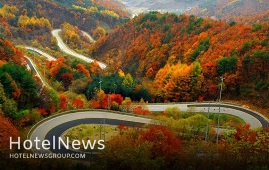
Preliminary work of collecting data about Karaj-Chalus road, its associated structures, and nearby villages has been commenced by the tourism directorate of Alborz province to have the scenic road registered on Iran’s national heritage list. Based on follow-up field visits and preliminary investigations, it was decided to develop a dossier for the national registration Karaj-Chalus road as a historical, cultural, and natural route that has considerable potential in the field of tourism, CHTN quoted the provincial tourism directorate as saying on Monday. Natural landscapes, villages with historical texture, the architecture of different periods, local food, traditional clothing, and the original Karaji dialect are among the attractions of the Karaj-Chalus axis, a provincial official said. In connection with political geography, the Karaj-Chalous road was once the most important route and connection of the southern slopes of Alborz to the northern regions of the country. As a piece of history, Chalus Road, also less well known as Road 59, was constructed during the Qajar era by the local people with very primitive hand tools. The 160 km road crossing and crawling up the Alborz Mountains offers beautiful landscapes, waterfalls, and springs. Each season presents its own special beauty along the road. The mesmerizing view changes as one travels on Chalus; from trees lining up on both sides of the pavement to getting engulfed and surrounded by the Alborz, and sometimes have dramatic views of the Karaj River, which runs along part of the road. The road between Tehran and the Caspian Sea has become a destination in itself for many Tehranis who take it just to escape the hustle and bustle of the city or for a relaxing day out with family and friends.
Create: May 26, 2021 Edit: May 26, 2021 Regional News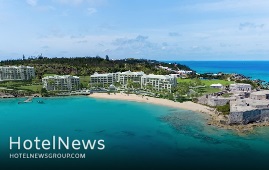
St. Regis Hotels & Resorts today announced the opening of The St. Regis Bermuda Resort. Extending the legacy of St. Regis from New York’s finest address of 55th and Fifth, the resort blends the timelessness of a bygone era with avant-garde Bermudian design and cultural influences. Situated in the historic Town of St. George’s, an UNESCO World Heritage site, and nestled among the soft sands and turquoise water of St. Catherine’s Beach, the resort is the first Marriott International luxury brand property to debut on the island. Drawing upon the celebrated spirit of leisure travel, The St. Regis Bermuda Resort seamlessly brings together elegant accommodations, exceptional amenities, and the brand’s signature Butler Service to create an enchanted island escape. “Bermuda has long served as an exclusive destination for the global luminaries, making it the ideal location to debut a glamorous new St. Regis resort. Much like the island, St. Regis is steeped in rich history, offering a storied past and exciting future,” said George Fleck, Vice President and Global Brand Leader for St. Regis Hotels & Resorts. “The St. Regis brand’s founding family, the Astors, spent time on this beautiful island more than a century ago. Now, the House of Astor’s celebrated traditions and rituals will bring this visionary spirit, avant-garde style and impeccable service back to Bermuda where our address is your muse.” Spanning St. Catherine’s Beach in a gentle arc, the OBMI designed architecture and interiors of The St. Regis Bermuda Resort draw inspiration from the destination’s notable local geography, heritage and traditions, beautifully weaving the island’s legacy together with the glamourous spirit and sophistication of St. Regis. The resort features 120 elegant guestrooms, including 21suites and an ultra-luxury residential development offering two and three-bedroom residences. Each guestroom features a private balcony and is designed to immediately draw the eye to expansive ocean views and stunning vistas of Bermuda’s celebrated Fort St. Catherine. Speaking to the island’s bold fortitude, stone foundations and formations inform texture and patterns, while the purposeful irreverence of Bermuda’s fashion is brought in through saturated colors and striking geometry. The St. Regis Bermuda Resort promises to be an enchanted beachfront oasis for guests and local luminaries alike,” said Jan Vanhaelewyn, General Manager at The St. Regis Bermuda Resort. “With bespoke service, exquisite design, outstanding culinary venues, the historic Five Forts Golf Course, and more than a dash of glamour, we hope to inspire and contribute to the local hospitality landscape and help elevate luxury in this iconic leisure destination.” The resort’s sophisticated food and beverage offerings include Lina, a flavorful all-day restaurant whose name is a playful nod to the nickname of St. Regis’ founding patroness Mrs. Caroline Astor. This venue features a delectable, light and fresh menu that leans into Bermuda’s coastal offerings and is inspired by the irreverent glamour of yachting clubs of the past. In the evening, the signature blackboards of famed BLT Steak NY will share daily specials, offering guests the finest in modern steakhouse fare. At the iconic St. Regis Bar, guests can socialize and celebrate while enjoying champagne, libations and light bites. The resort will also debut the Gates Bay Mary, its unique twist on the brand’s signature cocktail – the Bloody Mary. The Gates Bay Mary is named for the turquoise bay bordering the resort and infuses native fennel, Goslings Gold Seal Rum, Outerbridge’s Original Sherry Peppers Sauce, and a special spice mix created on the island Overlooking azure waters, the resort features both an adult and a family pool where guests can lounge luxuriantly or enjoy a private cabana for an exclusive retreat. Indulgence and relaxation awaits at the St. Regis Spa, which offers a comprehensive menu of unique personalized treatments using natural and precious elements and featuring products by Sothys. Additionally, a 24-hour fitness center offers state-of-the-art equipment. Younger guests will be able to enjoy unique amenities and enriching activities at The St. Regis Children’s Club, while Family Traditions programming offers meaningful excursions and experiences for the whole family. True to the Astors love for sports and speed, both guests and locals can relax with a day on the links or a night at the casino. Breathing new life into a historic landmark, the scenic Five Forts Golf Course is a marvelous and challenging 18-hole course. Named for the five notable forts that surround it, leisure seekers will tee off near Fort Victoria and enjoy captivating ocean views as they make their way through the 4,436-yard course, concluding at Fort St. Catherine. State-of-the-art, GPS-enabled golf carts will ensure the brand’s bespoke service reaches guests no matter where they are on the green. For a dazzling evening of sophistication and glamour, the resort proudly features the St. Regis brand’s first casino, slated to open later this year. This 5,500 sq. ft. gaming floor offers a variety of options for guests looking to roll the dice, in addition to a salon privé with two private tables. As the finest address for truly bespoke events and celebrations, the resort also features 10,989 sq. ft. of event space. Perfect for executive retreats, family gatherings, or enjoying milestone moments, offerings include a state-of-the-art boardroom, an exceptional ballroom that can host up to 150 people and a stunning terrace for oceanside events. The resort can also create a personalized, private set up on the beach while an additional event lawn located at the 18th hole of the Five Forts Golf Course offers spectacular sunset views overlooking both the ocean and Fort St. Catherine. Informed by the brand’s legacy of celebration from the Gilded Age to the present day, each event at The St. Regis Bermuda is thoughtfully curated and complemented with exceptional service.
Create: May 25, 2021 Edit: May 25, 2021 International News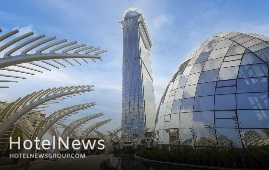
St. Regis Hotels & Resorts, part of Marriott Bonvoy’s portfolio of 30 extraordinary brands, today announced the highly anticipated debut of The St. Regis Dubai, The Palm. Heralding the storied heritage and celebrated traditions of St. Regis, this hotel joins a dynamic global portfolio and brings the brand’s signature hallmarks of bespoke service, innovative design, and exquisite experiences to the world-famous island and cosmopolitan city of Dubai. “With its spectacular skyline, breathtaking desert landscapes, contemporary architecture, thriving culture and varied entertainment offerings, Dubai is one of the most sought-after destinations for global leisure travellers,” said Sandeep Walia, Area Vice President – United Arab Emirates, Marriott International. “The St. Regis Dubai, The Palm is an exquisite addition to our global portfolio and offers a century-old legacy of uncompromising refinement and bespoke service on Dubai’s iconic Palm Jumeirah.” “We are delighted to welcome the St. Regis brand to our portfolio of hospitality partners. Palm Jumeirah is firmly established as world-leading destination for living, leisure and tourism, and the opening of The St. Regis Dubai, The Palm brings yet another world-class hospitality offering to the island’s ever-growing list of attractions, including The View, which opened at the top of The Palm Tower last month. With its enviable location, luxury facilities and signature service, the hotel is sure to be a draw for UAE residents and Dubai’s regional and global luminaries,” said Omar Khoory, Chief Assets and Hospitality Officer at Nakheel. Sophisticated Design and Exceptional AccommodationsDesigned to feature the brand’s sophisticated aesthetic, The St. Regis Dubai, The Palm balances local influences with the modern glamour and visionary spirit of St. Regis. Elegant décor and contemporary interiors are accentuated with bespoke elements such as the hotel’s grand staircase, which is embellished with gold detailing that encircles an exquisite chandelier. Inspired by the Arabian palm tree, the chandelier is gilded with shimmering crystals that gracefully illuminate the ground floor of the hotel. The intimate lobby features plush lounge areas and a tucked-away library lit by an artful fireplace. The corridors and gathering spaces are adorned with a thoughtfully curated art collection featuring contemporary artwork and paintings. The 264 lavishly appointed guestrooms and 26 elegant suites offer luxuriant comfort, exceptional amenities and expansive views of Palm Jumeirah, the Arabian Gulf and the Dubai skyline through floor-to-ceiling windows. The St. Regis Dubai, The Palm features the renowned hallmarks of the St. Regis brand, including St. Regis Butler Service, which allows each guest to customise their stay according to personal tastes and preferences. Distinctive Culinary ExperiencesThe hotel is a vibrant lifestyle destination with a diverse selection of restaurants, bars and lounges. Cordelia sets the tone for a sophisticated evening, offering a variety of flavourful cuisine, including premium cuts of meat and seafood sourced from around the world – expertly prepared and grilled to perfection. Her by Caroline Astor offers an elegant gathering place to enjoy the brand’s signature Afternoon Tea. The ladies-only venue is an intimate setting and features curated tea pairings and a locally inspired take on this acclaimed St. Regis ritual. The iconic St. Regis Bar extends the legacy of the King Cole Bar at the brand’s flagship property at 55th and Fifth Ave. in New York City, where the world-renowned Bloody Mary cocktail was born in 1934. Guests can enjoy The Glitzy Mary, a locally inspired take on the brand’s signature beverage, which features traditional Emirati flavours including date syrup, an aromatic bezaar spice blend, sun-dried lime and earthy saffron. The poolside restaurant, Dip Pool Bar, with scenic views of Dubai’s skyline, is the ideal place to relax and enjoy a light meal. Honouring a signature tradition at St. Regis properties around the world, The St. Regis Dubai, The Palm marks the transition from day to evening with a celebratory sabering at dusk. Rejuvenation for the Body and SoulA luxurious oasis, The St. Regis Spa offers transformative and bespoke signature treatments including the Signature Gold Journey, which uses 24k gold to nourish and strengthen the skin. Guests can work out in the exclusive Fitness Center, featuring a range of cardio and strength equipment, or enjoy a leisurely swim in a choice of two pools, one for families and one for adults. The hotel is also steps away from soft sandy beaches and the soon-to-open St. Regis Beach Club. A Sophisticated Destination for Bespoke EventsMarking the brand’s legacy of iconic celebrations, The St. Regis Dubai, The Palm boasts an elegant Astor Ballroom, which is brightly lit with natural daylight and features grand sculpted doors, blended silk rugs and a striking chandelier with abstract fluted glass leaves. From intimate events to lavish celebrations and business gatherings alike, the hotel offers choice and flexibility with its six multi-purpose meeting rooms all equipped with state-of-the-art technology. “We are delighted to have opened the doors of The St. Regis Dubai, The Palm and look forward to inviting guests to enjoy our rituals and traditions, alongside exceptional luxury and anticipatory service,” said Marwan Fadel, General Manager, The St. Regis Dubai, The Palm. The City’s Finest AddressThe St. Regis Dubai, The Palm occupies the first 18 floors of The Palm Tower, a stunning new 52-story landmark development connected to the Nakheel Mall which offers world class shopping, a variety of culinary venues and entertainment options. Guests can also access the Palm Monorail from the mall for a scenic route to the landmarks of Palm Jumeirah. On the 52nd floor of the tower, The View at The Palm is an exclusive observation deck that rests 240 metres above the iconic island and offers sweeping, 360-degree views of Palm Jumeirah, the Arabian Gulf and the city skyline, as well as an interactive experience showcasing the history and creativity behind the island. The hotel is also a three-minute drive to The Pointe, an iconic waterfront destination, with restaurants, shops, and the world’s largest fountain measuring 7,327 square metres.
Create: May 22, 2021 Edit: May 22, 2021 International News
